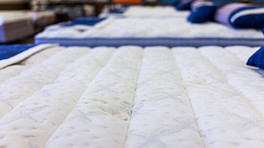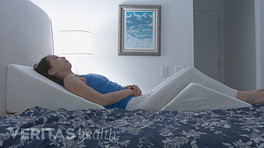Using the best pillow for both comfort and support can make a major difference in alleviating or avoiding back pain or neck pain, as well as getting a good night’s sleep.
In This Article:
- Pillow Support and Comfort
- Best Pillows for Different Sleeping Positions
- Different Types of Pillows
- Best Pillows for Neck Pain or Back Pain Video
Orthopedic Pillows Offer Extra Neck Support
A pillow contoured to fill the spaces under the head and neck can be helpful for people with cervical spine problems. Also called cervical pillows or orthopedic pillows, this type of pillow has a deeper depression where the head lies, and extra support under the neck.
People with cervical pain may favor these pillows, as they help keep the neck in alignment with the spine. Some individuals find these pillows uncomfortable at first, but helpful over the long term.
Body Pillows Fit Many Needs
A pillow as long as the body can serve several functions for people who prefer to sleep on their sides. The top portion can support the head and neck, while the bottom portion supports the knees and legs. One style, in a J shape with space for the ear, is designed to hold the head in correct spinal alignment.
Using one body pillow is sometimes preferred to using separate pillows for the head and knees. Women who are pregnant may also appreciate the added support for the abdomen.
See Management of Back Pain in Pregnancy
Throwing the top leg too far across the body pillow while side sleeping can cause the lower back to twist and should be avoided. The legs should remain aligned, one directly over the other, with the pillow in between.
Personal Preference for Comfort
Personal preference is a major part of any pillow choice. If the pillow feels comfortable, it’s easier to fall asleep and stay asleep.
Pillowcase texture
The pillow's surface can be one source of comfort. A cool, smooth-feeling pillowcase is perfect for some, while warm surfaces, such as flannel, are best for others.
Cool vs. warm
Researchers tested the warmth of three kinds of pillows after 30 minutes of use. The contoured orthopedic pillows, which have higher sides for the neck and a lower area for the head, were the coolest. Feather pillows (standard shape) were the warmest. The contoured memory foam pillows were in the middle. 1 Kim HC, Jun HS, Kim JH, Ahn JH, Chang IB, Song JH, Oh JK. The Effect of Different Pillow Heights on the Parameters of Cervicothoracic Spine Segments. Koran J Spine. 2015 Sep; 12(3); 135-138. Published online 2015 Sep 30.
Pillows Come in Many Options
There are plenty of choices when it comes to pillow materials. More than one type of material, such as latex and shredded foam, may be combined for the filling. These are some of the most common fillings:
- Down or Polyester (may be labeled “down alternative”)
- Latex
- Memory foam
- Water
- Buckwheat hulls
There are no government standards for the terms soft, medium, or firm in pillows. Since it can be difficult to test a pillow in the store, it is worthwhile to check the store’s policy on returns.
It may be worthwhile to sometimes try an alternative to more conventional pillows. For example, doctors report anecdotal evidence that buckwheat hull pillows seem to be a well tolerated pillow for those with moderate to severe disc degeneration, osteoarthritis, and spinal stenosis, and tend to work well for both back and side sleepers.
Pillows for Every Need
Specialty pillows are available in an array of sizes and shapes. These are some of the most common types and their uses:
- Wedge pillows. People recovering from back surgery and those with chronic back pain often find recliners especially comfortable. Wedge pillows recreate the recliner position in bed. Two-piece wedge cushion sets provide a similar raised position for the upper body and legs.
- Travel pillows. Small U-shaped pillows designed for travel prevent the head from bending too far to one side or another while sitting up in a car or airplane. The takes on some of the work that would normally be done by the muscles to keep the head up. Those needing to save space may wish to buy an inflatable travel pillow.
- Coccyx cushion. These pillows have a depression or a hole in the back, allowing the individual to sit on a chair without direct pressure in the coccyx region (the tailbone). Those who have suffered a broken or bruised tailbone or have coccygeal pain (such as coccydynia) may need this type of pillow.
- Lumbar support pillow. Used when in a seated position, a lumbar support pillow fills the natural gap between the lower spine and the chair to maintain the natural inward curve in the lower back. Lumbar back support is also helpful when sitting in a car. When the lumbar curve is supported, the downward forces of gravity are better absorbed, as opposed to a non-supported straight or slouched lumbar spine.
Many pillows can be washed following label directions. It is generally advised that a pillow be replaced after about 2 to 3 years, or earlier if the pillow is no longer supportive.
- 1 Kim HC, Jun HS, Kim JH, Ahn JH, Chang IB, Song JH, Oh JK. The Effect of Different Pillow Heights on the Parameters of Cervicothoracic Spine Segments. Koran J Spine. 2015 Sep; 12(3); 135-138. Published online 2015 Sep 30.











